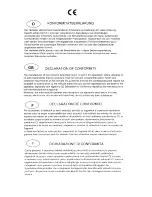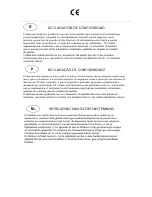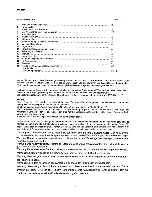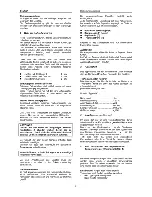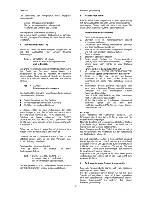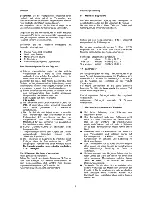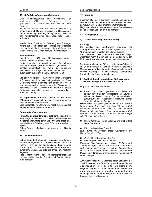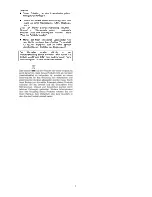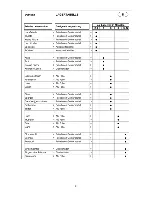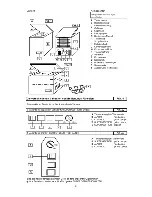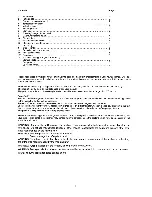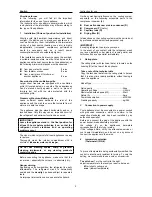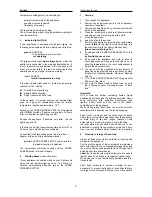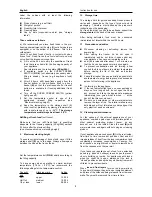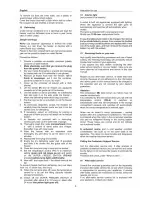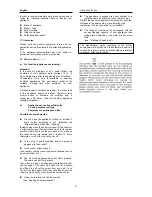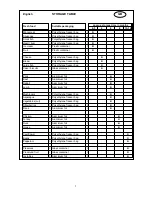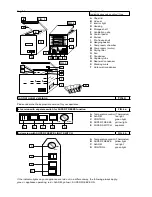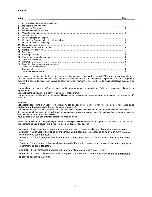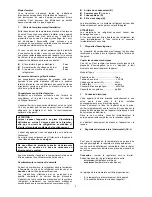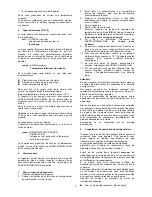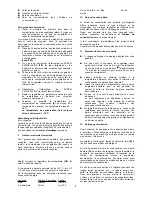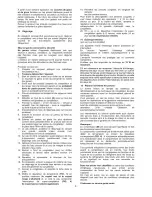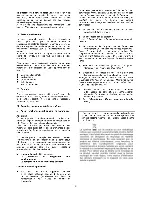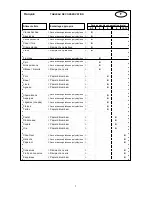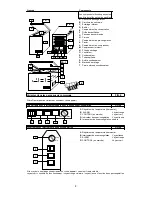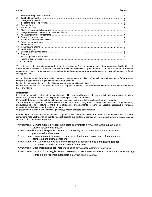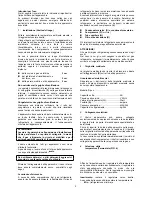
English
Temperature settings must be according to:
-
ambient temperature of the appliance
-
quantity of stored foodstuff
-
frequency of opening
We recommend a medium setting.
You will soon learn which is the most suitable setting for
your requirements.
5 Indicator-lights
(FIG.4)
If your appliance is equipped with indicator-lights, the
following guide explains what is meant by each light up:
-
green =
CONTROL
The appliance is under current
and
operating
The
green
control light
must always be on
when the
appliance is connected to the mains and switched on. It
is very important to pay attention to this, because in the
event of a power failure, the red and yellow lights stop
operating and do no longer provide a warning.
-
- red =
ALARM
Interior temperature too high
If the red indicator-light goes on, there may be several
reasons for this, namely:
First start-up of appliance
Restart after defrosting
Filling freezer with fresh food
In these cases it is normal that the red indicator-light
goes on. It goes off automatically when the interior
temperature reaches approximately –15°C.
Switch on the SUPER FREEZE SWITCH (if equipped
with)
(FIG.4)
.
(switch off again not more than 24 hours
later or when the red light has gone off).
Reopen the appliance, if possible, only after the red
light has gone off.
If the red control light nevertheless stays on after 12 to
24 hours, there may be serious problems.
Consult the Troubleshooting guide “ what is when...”
chapter at the end of this operating manual.
-
yellow =
SUPER FREEZE SWITCH is on and the
thermostat function is disabled.
The compressor continues cooling until the SUPER
FREEZE switch is turned off again.
6 Warning
Buzzer
(Acoustic alarm)
If your appliance is supplied with a buzzer, it will sound
when the red indicator-light goes on. The buzzer is
silenced automatically when you turn on the SUPER
FREEZER SWITCH.
Instruction for use
7 Start-up
1. Fully unpack the appliance.
2. Remove the polystyrene parts in the compressor
chamber (if supplied).
3. Remove documents and any accessories from the
inside of the appliance.
4. Clean the interior with a mixture of lukewarm water
and vinegar, and dry thoroughly with a cloth.
5. Close the appliance.
6. Insert the plug in the socket
7. Switch on the appliance by turning the temperature
control
(FIG.4)
to the right (For the time being, turn
the controller fully to the right to Max position).
(green and red lights go on).
8. If equipped with a SUPER FREEZE SWITCH, turn
it on
(
yellow light goes on too).
9. Do not open the appliance any more for about 4
hours respectively as long as the red light is on, to
allow the temperature in the inner compartment to
drop to the necessary level.
10. You can now fill the appliance with any amount of
deep frozen food (purchased ready frozen goods).
(Consult the following chapter “Maximum stacking
height”).
11. Turn off the SUPER FREEZE SWITCH again after
24 hours at the latest.
12. If you wish to freeze fresh, unfrozen food, go on to
the following chapter “
Freezing/storage of fresh
food”.
Important!
Do not store any bottles containing liquids. Liquid
expands when frozen and the bottle can explode. Never
keep containers with explosive substances (gas
lighters, petrol, ether and the like) in the freezer
compartment of the appliance.
When storing ready frozen food, you must observe the
manufacturer’s instructions on the food packaging.
Deep frozen ice-cream and ice lollies must be eaten
only a few minutes after being taken from the appliance
to avoid injury to lips and tongue (danger of skin
detachment). For the same reason, avoid touching
the inner walls with wet hands. We advise you to use
defrosted or slightly frozen products within short time.
As a rule, such products are not suitable for re-freezing.
8
Freezing / storage of fresh food
Almost all fresh products are suitable for freezing and
storage in the appliance.
For the most common of these products, we provide a
table with instructions on acceptable storage times and
the most suitable packing material (see
“storage table”
at the back of this user manual).
Label
the fresh products clearly as they are not easy to
identify when deep frozen in transparent freezer-bags.
We advise you to use commercially available labels for
frozen foods.
Pack fresh products in portions suitable for your
household to prevent defrosting of quantities that are
too large for consumption in one day in your household.
3
Summary of Contents for BD-103G
Page 2: ......
Page 3: ......
Page 4: ...1 ...
Page 5: ...2 ...
Page 6: ...3 ...
Page 7: ...4 ...
Page 8: ...5 ...
Page 9: ...6 ...
Page 10: ...7 ...
Page 11: ...8 ...
Page 12: ...9 ...
Page 13: ...1 ...
Page 17: ...5 ...
Page 21: ...1 ...
Page 25: ...5 ...
Page 26: ...6 ...
Page 29: ...1 ...
Page 33: ...5 ...
Page 37: ...1 ...
Page 41: ...5 ...
Page 45: ...1 ...
Page 49: ...5 ...
Page 53: ...1 ...
Page 57: ...5 ...
Page 61: ......


